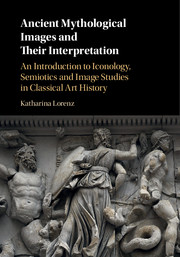 Ancient Mythological Images and their Interpretation
Ancient Mythological Images and their Interpretation Book contents
- Frontmatter
- Dedication
- Contents
- List of figures
- Preface
- The experiment: methods – images – objects
- ICONOLOGY
- SEMIOTICS
- IMAGE STUDIES
- 7 Introducing image studies
- 8 Image studies in action
- 9 Narratives of space and perspective
- 10 The study of mythological images as threesome – assessing the experiment
- Bibliography
- Index
10 - The study of mythological images as threesome – assessing the experiment
from IMAGE STUDIES
Published online by Cambridge University Press: 05 August 2016
- Frontmatter
- Dedication
- Contents
- List of figures
- Preface
- The experiment: methods – images – objects
- ICONOLOGY
- SEMIOTICS
- IMAGE STUDIES
- 7 Introducing image studies
- 8 Image studies in action
- 9 Narratives of space and perspective
- 10 The study of mythological images as threesome – assessing the experiment
- Bibliography
- Index
Summary
Where painting continues to galvanise writing, that writing is both more and less than painting's supplement. If supplement is that which completes, fulfils, terminates, it is a word that cannot apply to the uncurtailable activity of recognition. If supplement is addition over and beyond an existing boundary, the image is unbounded, and least of all by the four walls of the frame. Writing is the trace of an encounter which will never know the object in absolute terms, but which will continue for as long as the image can circulate within society; for as long as the image remains alive.
Bryson 1983: 85–6Everyone knows that images are, unfortunately, too valuable, and that is why they need to be put down. Mere images dominate the world. They seem to simulate everything, and therefore they must be exposed as mere nothings. How is this paradoxical magic/nonmagic of the image produced? What happens to an image when it is the focus of both over- and underestimation, when it has some form of ‘surplus value’? How do images accrue values that seem so out of proportion to their real importance? What kind of critical practice might produce a true estimation of images?
Mitchell 2005: 76The authors of the analytical models sketched out at the beginning (Sedlmayr, Bauch, and Panofsky) define their own scholarly habitat only indirectly. They assume a universal validity of their models and therefore do not specially position themselves within academic discourse. Since the 1970s, rigorous scholarly work is increasingly expected to reflect upon its own, implicit theoretical habitat and to expatiate upon it. This – mostly still only implied – imperative already alleges that no single theory can lay claim to providing the one single truth, and that instead a plurality of scholarly models exists which all can claim equal feasibility. This means on the side of the object, the artefact to be interpreted, that its semantic potential is turned into a function of the conditions of its reception. By means of its analysis, it might be refreshed, or (in parts) remain arcane. In order to fight the interpretive arbitrariness that might arise from this, it is paramount always to assess the historical pertinence, an assessment with regard to the ‘emission level’ of the work of art, its intentions and the options of its reception for the primary communicative community.
Information
- Type
- Chapter
- Information
- Ancient Mythological Images and their InterpretationAn Introduction to Iconology, Semiotics and Image Studies in Classical Art History, pp. 236 - 245Publisher: Cambridge University PressPrint publication year: 2016